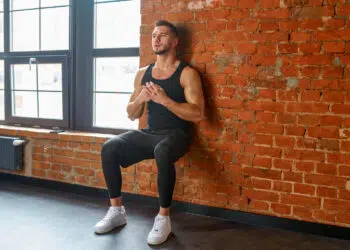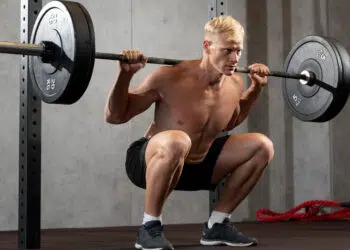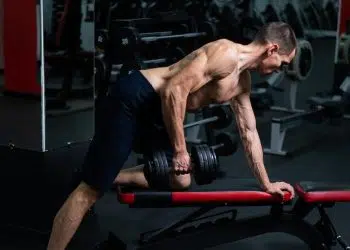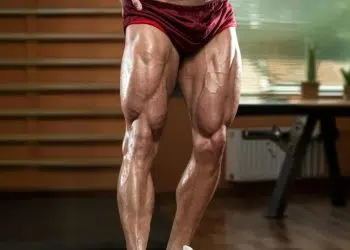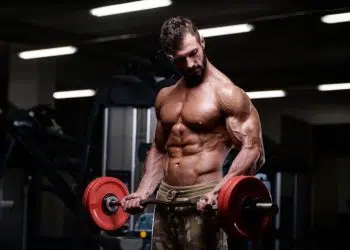Squats are often called the king of exercises, and that’s a title they truly deserve.
Whether you want to build muscle mass, get stronger, improve your athletic performance or lose fat, squats should be high on your list of must-do exercises. The squat is also a fundamental movement pattern that most people do many times each day. If you’re sitting down while you read this article, it’s safe to say you’ve done at least one squat today.
Squats are such an important exercise that entire workouts have been written around them, such as the famous old-school 20-rep squat routine.
When it comes to squats, most people tend to gravitate toward two main variations – back squats and front squats. These are both superb exercises, and it’s very hard to choose between them.
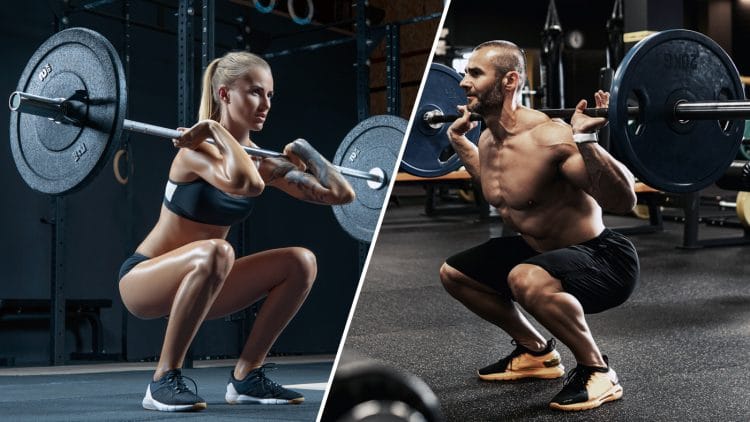
However, doing the same exercises over and over again can become boring, and boredom can be the death of gains!
Level Up Your Fitness: Join our 💪 strong community in Fitness Volt Newsletter. Get daily inspiration, expert-backed workouts, nutrition tips, the latest in strength sports, and the support you need to reach your goals. Subscribe for free!
Keep your workouts fresh and productive with these 12 unique squat variations.
1. Goblet Cyclist Squat
The regular goblet squat is a great exercise. It’s easy to learn, safe to do on your own, and helps to reinforce good squatting technique. This variation is more quads-centric and perfect for building bigger thighs. If you’ve ever been envious of cyclists’ leg development, this is the exercise for you.
How to do it:
- Place a 45-pound/20-kilogram bumper plate on the floor. Stand on it, so your feet are close together, heels are raised, and your toes are turned slightly outward.
- Hold a kettlebell or dumbbell in front of your chest, just below your chin. Brace your core, lift your chest, and pull your shoulders down and back.
- Keeping your torso upright, bend your legs, and squat down as deeply as you can. Do not round your lower back.
- Without bouncing, stand back up, stopping just short of fully extending your knees to keep your muscles under constant tension.
- Repeat for the desired number of reps.
2. Front-Facing Wall Squat
Squats require good mobility and flexibility, especially if you want to squat deep, i.e., ass to grass. While stretching can help, static stretching before heavy squats can rob you of vital strength as it tends to make your muscles relax.
The front-facing wall squat is a squat mobility exercise that’s perfect for preparing your body for your squat workout. It also teaches you to maintain an upright torso. Done for high reps, this exercise could also be good for conditioning.
That said, if your muscles are tight, you will find this exercise very challenging, indicating that you really need to start doing more mobility and stretching.
How to do it:
- Stand about 12 inches from a smooth wall. You should be facing the wall with your feet about shoulder-width apart, toes turned slightly outward. Raise your arms above your head to form a Y-shape. Brace your abs.
- Push your hips back, bend your knees, and squat down as far as your knee health and flexibility allow. Do not let any part of your body touch the wall, and don’t round your lower back.
- Stand back up and repeat.
- Move back from the wall if you touch it. Decrease the distance between your feet and the wall as your mobility improves.
3. Anderson Squat
Traditional squats start from standing. Anderson squats, named after legendary old-school strongman Paul Anderson, start from the bottom position with the bar resting on the pins of a power rack.
Also known as dead-stop squats, starting each rep from the bottom forces you to stand up explosively, which increases power out of “the hole.” Powerlifters use Anderson squats as an accessory exercise to improve squat performance.
Even if you’re not a powerlifter, Anderson squats are a unique variation that will add a new dimension to your leg workouts.
How to do it:
- Set the safety pins of your power rack to the bottom height of your squat. Place your barbell on the pins.
- Squat down and get under the bar. Adopt a good squat stance, brace your core and get tight. Make sure your lumbar spine is neutral, and not rounded.
- Drive your feet into the floor and stand up explosively.
- Squat back down and lower the bar to the pins, allowing it to settle for a second or two (no bouncing!) and then repeat.
4. Eccentric Single-Leg Box Squats
If you’ve ever tried single-leg or pistol squats, you already know just how challenging they are, even with just your body weight. This variation emphasizes the negative portion of the exercise and uses a box to give you a target to descend to.
As such, it’s a more accessible exercise than pistols, and because you are stronger eccentrically than concentrically, you may find you can use more than just your bodyweight.
However, be warned, eccentric contractions cause a lot of muscle microtrauma, which is good for hypertrophy but not so good for post-workout muscle soreness!
How to do it:
- Rack and hold a barbell across the front of your shoulders or hold a single dumbbell or kettlebell in front of your chest as if you’re doing goblet squats. You can also do this exercise without weight.
- Stand with your back to a sturdy knee-high box or bench. Brace your core.
- Extend one leg out in front of you, toes pointing up at the ceiling.
- Bend your supporting leg and slowly descend to sit on the bench/box.
- Use both legs to stand up and repeat.
- Do all your reps on one side and then switch, or alternate legs rep by rep as preferred.
Level Up Your Fitness: Join our 💪 strong community in Fitness Volt Newsletter. Get daily inspiration, expert-backed workouts, nutrition tips, the latest in strength sports, and the support you need to reach your goals. Subscribe for free!
5. Goblet Band Squat
No weights? No problem! You can get a great leg workout using nothing but a resistance band. These goblet band squats overload your quads but really fire up your glutes and hamstrings as you’ll need to work harder than usual to keep your torso upright.
How to do it:
- Stand on your band with your feet shoulder-width apart, toes turned slightly outward. Hold the other end of the band in front of your chest, just like you are about to do regular goblet squats.
- Brace your abs, pull your shoulders down and back, and look straight ahead.
- Bend your knees and squat down as far as your flexibility allows. Do not round your lower back or lean excessively forward.
- Stand back up and repeat.
6. 1 ½ Rep Squats
This squat variation will make your quads burn like no other. It’s an excellent choice for bodybuilders and anyone looking to add size to their thighs. You can apply this variation to goblet squats, front squats, back squats, or split squats. You can also do 1 ½ rep squats using just your body weight.
How to do it:
- Adopt your usual squat stance and hold your weights as appropriate. Brace your core and pull your shoulders down and back. Look straight ahead.
- Bend your knees and descend into a deep squat. Do not round your lower back.
- Come up halfway, and then descend again.
- Stand all the way up and repeat.
7. Kang Squat
The Kang squat combines back squats with good mornings to produce a demanding, total leg workout. This exercise is not for the faint-hearted and requires good mobility, coordination, and core strength to do correctly. As such, start with light weights and only go heavier when you’ve perfected your technique.
How to do it:
- Rack and hold a barbell across your upper back. Stand with your feet shoulder-width apart, core braced. Bend your knees slightly.
- Hinge forward from your hips and perform a good morning. Lean as far forward as you can without rounding your lower back.
- Next, bend your legs and descend into a squat. Again, do not round your lumbar spine.
- Continuing to lean forward, drive up and out of the squat.
- Finally, stand up straight by doing a reverse good morning.
- That’s one rep – keep going!
8. Skater Squat
Single leg squats are a great way to overload your muscles without using much in the way of additional weight. They’re also helpful for fixing left to right strength imbalances and improving coordination and balance. Skater squats are a little easier to master than pistols as they require less flexibility.
How to do it:
- Hold a light dumbbell in each hand for balance and stand on one leg.
- Bend your supporting leg and descend until your non-working knee lightly touches the floor. Simultaneously raise your arms forward to maintain your balance.
- Stand back up and repeat.
- Make this exercise easier by placing a low platform behind you, so you don’t have to descend as far. Increase the height of the platform as you get stronger.
9. Paused Squat
Adding a mid-rep pause increases time under tension which makes squats more demanding. You can add a pause to most types of squats, including front, back, goblet, and even Bulgarian split squats. The longer you pause, the harder your workout will be, but 2-3 seconds is a good target for most people.
How to do it:
- Adopt your usual squat stance. Brace your core, pull your shoulders down and back, and look straight ahead.
- Squat down and then pause at the lowest point. Do not relax – stay braced and tight; remain in this position for 2-3 seconds.
- Stand back up and repeat.
10. Zercher Squat
Zercher squats are named after St. Louise strongman Ed Zercher. He invented this exercise when he was forced to train without a squat rack. It involves resting and holding a barbell in the crook of your elbows instead of your upper back or the front of your shoulders.
This weight position increases upper body muscle engagement. Also, it puts more tension on your glutes and hamstrings, as you’ll need to work harder to keep your torso upright.
On the downside, Zercher squats can be hard on your arms, so use a squat bar pad, folded gym mat, or wear elbow sleeves for a more comfortable workout.
How to do it:
- Place your barbell in a squat or power rack set to about waist height. Hook your arms under the bar, so it rests in the crooks of your elbows. Clasp your hands together if you wish.
- Unrack the bar and stand with your feet shoulder-width apart, toes turned slightly outward. Brace your core and pull your shoulders down and back.
- Bend your legs and squat down until your thighs are roughly parallel to the floor. Do not round your lower back.
- Stand back up and repeat.
11. Offset Load Barbell Squats
While all types of squats involve your core, this variation kicks things up a notch. With a 5-10% weight imbalance, you’ll be forced to brace even harder than usual to keep your torso upright. This is not just an excellent way to train your core at the same time as your legs; it’s also a valuable tool for reinforcing correct form as it reminds you to stay tight throughout your set.
How to do it:
- With your barbell in a squat rack, load up the weights, so you have 5-10% more weight on one side.
- Adopt your usual squat stance and brace your core. Make sure the bar is level.
- Squat down as deep as your knee health and flexibility allow. Do not lean sideways or shift your weight onto one foot more than the other.
- Stand back up and repeat.
- Do your next set with the weight imbalance on the other side.
12. Kickstand Squat
Transitioning from two-legged to single-legged squats can be a real shock to the system, as well as your legs. The kickstand squat is a good compromise between regular and single-leg squats, as you get to use one leg for balance and assistance. You can use the kickstand method with barbell, goblet, or bodyweight squats as needed.
How to do it:
- Take a small step out and back and place the ball of your foot on the floor. Most of your weight should be on your front leg.
- Bend your legs and squat down until your front thigh is roughly parallel to the floor. Use your rear leg for balance and support only.
- Stand back up and repeat.
- Rest a moment, swap sides, and do the same number of reps on the other side.
Squat Variations – Wrapping Up
If you want a strong, muscular, functional body, you’ve got to squat! For many people, that means front or back squats, but your choices don’t have to be so limited. There are lots of squat variations you use to develop the body of your dreams, and we’ve just listed 12 of the best.
So, keep your leg workouts varied, interesting, challenging, and fun with these 12 unique squat variations. There is nothing wrong with plain vanilla front and back squats. But, if you want a bit more spice in your workouts, these exercises deliver!
Interested in measuring your progress? Check out our strength standards for Zercher Squat, Good Morning, Bulgarian Split Squat, and more.


